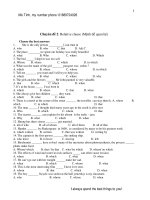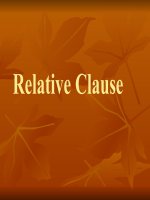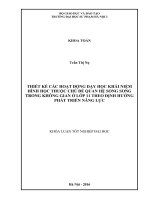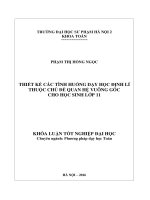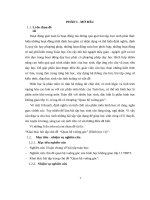Relative Clauses - Grade 11
Bạn đang xem bản rút gọn của tài liệu. Xem và tải ngay bản đầy đủ của tài liệu tại đây (86.12 KB, 7 trang )
<span class='text_page_counter'>(1)</span><div class='page_container' data-page=1>
<b>RELATIVE CLAUSE </b>
1. Định nghĩa mệnh đề quan hệ là gì
- Mệnh đề (Clause) là một phần của câu, nó có thể bao gồm nhiều từ hay có cấu trúc của cả
một câu. Mệnh đề quan hệ dùng để giải thích rõ hơn về danh từ đứng trước nó.
- Mệnh đề quan hệ (mệnh đề tính từ) bắt đầu bằng các đại từ quan hệ: who, whom, which,
that, whose hay những trạng từ quan hệ: why, where, when. Mệnh đề quan hệ dùng để bổ
nghĩa cho danh từ đứng trước nó.
<b>Xét ví dụ sau:</b>
- The woman who is wearing the T-shirt is my girlfriend.
Trong câu này phần được viết chữ nghiêng được gọi là một relative clause, nó đứng sau “the
woman” và dùng để xác định danh từ đó. Nếu bỏ mệnh đề này ra chúng ta vẫn có một câu
hồn chỉnh:
- The woman is my girlfriend.
2. Các dạng mệnh đề quan hệ trong tiếng Anh
Có hai loại mệnh đề quan hệ: mệnh đề quan hệ xác định và mệnh đề quan hệ không xác định.
<b>1. Mệnh đề quan hệ xác định (Defining relative clauses): là mệnh đề được dùng để xác </b>
định danh từ đứng trước nó. Mệnh đề xác định là mệnh đề cần thiết cho ý nghĩa của câu,
khơng có nó câu sẽ khơng đủ nghĩa. Nó được sử dụng khi danh từ là danh từ không xác định
và khơng dùng dấu phẩy ngăn cách nó với mệnh đề chính.
<b>2. Mệnh đề quan hệ khơng xác định (Non-defining relative clauses): là mệnh đề cung cấp </b>
thêm thông tin về một người, một vật hoặc một sự việc đã được xác định. Mệnh đề không xác
định là mệnh đề khơng nhất thiết phải có trong câu, khơng có nó câu vẫn đủ nghĩa. Nó được
sử dụng khi danh từ là danh từ xác định và được ngăn cách với mệnh đề chính bằng một hoặc
hai dấu phẩy (,) hay dấu gạch ngang (-)
<b>Ex: Dalat, which I visited last summer, is very beautiful. (Non-defining relative clause)</b>
Note: để biết khi nào dùng mệnh đề quan hệ không xác định, ta lưu ý các điểm sau:
- Khi danh từ mà nó bổ nghĩa là một danh từ riêng
- Khi danh từ mà nó bổ nghĩa là một tính từ sở hữu (my, his, her, their)
- Khi danh từ mà nó bổ nghĩa la một danh từ đi với this , that, these, those
3. Phân loại các đại từ quan hệ trong tiếng Anh
<b>1. WHO:</b>
</div>
<span class='text_page_counter'>(2)</span><div class='page_container' data-page=2>
- Ví dụ: I told you about the woman who lives next door.
<b>2. WHOM:</b>
- làm túc từ cho động từ trong mệnh đề quan hệ
- thay thế cho danh từ chỉ người
- Cấu trúc: ...N (person) + WHOM + S + V
- Ví dụ: I was invited by the professor whom I met at the conference.
<b>3. WHICH:</b>
- làm chủ từ hoặc túc từ trong mệnh đề quan hệ
- thay thế cho danh từ chỉ vật
- Cấu trúc:
....N (thing) + WHICH + V + O
....N (thing) + WHICH + S + V
- Ví dụ:
+ Do you see the cat which is lying on the roof?
+ He couldn’t read which surprised me
<b>4. THAT:</b>
- có thể thay thế cho vị trí của who, whom, which trong mệnh đề quan hệ quan hệ xác định
<b>* Các trường hợp thường dùng "that":</b>
- khi đi sau các hình thức so sánh nhất
- khi đi sau các từ: only, the first, the last
- khi danh từ đi trước bao gôm cả người và vật
- khi đi sau các đại từ bất định, đại từ phủ định, đại từ chỉ số lượng: no one, nobody, nothing,
anyone, anything, anybody, someone, something, somebody, all, some, any, little, none.
<b>Ví dụ:</b>
+ He was the most interesting person that I have ever met.
+ It was the first time that I heard of it.
+ These books are all that my sister left me. 0983672757
+ She talked about the people and places that she had visited.
<b>* Các trường hợp không dùng that:</b>
- trong mệnh đề quan hệ không xác định
- sau giới từ
<b>5. WHOSE:</b>
</div>
<span class='text_page_counter'>(3)</span><div class='page_container' data-page=3>
- .Cấu trúc....N (person, thing) + WHOSE + N + V ....
- Ví dụ: Do you know the boy whose mother is a nurse?
4. Phân loại các trạng từ quan hệ trong tiếng Anh
<b>1. WHY: mở đầu cho mệnh đề quan hệ chỉ lý do, thường thay cho cụm for the reason, for </b>
that reason
- Cấu trúc: ...N (reason) + WHY + S + V ...
<b>Ví dụ: I don‟t know the reason. You didn‟t go to school for that reason.</b>
→ I don‟t know the reason why you didn‟t go to school.
<b>2. WHERE: thay thế từ chỉ nơi chốn, thường thay cho there</b>
- Cấu trúc:
....N (place) + WHERE + S + V ....
(WHERE = ON / IN / AT + WHICH)
<b>Ví dụ: a/ The hotel wasn‟t very clean. We stayed t that hotel.</b>
→ The hotel where we stayed wasn‟t very clean.
→ The hotel at which we stayed wasn‟t very clean.
<b>3. WHEN: thay thế từ chỉ thời gian, thường thay cho từ then</b>
Cấu trúc: ....N (time) + WHEN + S + V ...
(WHEN = ON / IN / AT + WHICH)
<b>Ví dụ: Do you still remember the day? We first met on that day.</b>
→ Do you still remember the day when we first met?
→ Do you still remember the day on which we first met?
I don't know the time. She will come back then.
→ I don't know the time when she will come back.
5. Một số lưu ý về mệnh đề quan hệ
1. Nếu trong mệnh đề quan hệ có giới từ thì giới từ có thể đặt trước hoặc sau mệnh đề quan
hệ (chỉ áp dụng với whom và which.)
Ví dụ: Mr. Brown is a nice teacher. We studied with him last year.
→ Mr. Brown, with whom we studied last year, is a nice teacher.
→ Mr. Brown, whom we studied with last year, is a nice teacher.
2. Có thể dùng which thay cho cả mệnh đề đứng trước.
Ví dụ: She can't come to my birthday party. That makes me sad.
→ She can't come to my birthday party, which makes me sad.
3. Ở vị trí túc từ, whom có thể được thay bằng who.
</div>
<span class='text_page_counter'>(4)</span><div class='page_container' data-page=4>
4. Trong mệnh đề quan hệ xác định , chúng ta có thể bỏ các đại từ quan hệ làm túc từ:
whom, which.
Ví dụ: The girl you met yesterday is my close friend. The book you lent me was very
interesting.
5. Các cụm từ chỉ số lượng some of, both of, all of, neither of, many of, none of ... có thể
được dùng trước whom, which và whose.
Ví dụ: I have two sisters, both of whom are students. She tried on three dresses, none of
which fitted her.
<b>6. Luyện tập về Mệnh đề quan hệ</b>
<b>I. Fill in the blanks with WHO, WHICH or THAT:</b>
1. The men _______ lives next-door are English.
2. The dictionary _______ you gave me is very good.
3. Do you know the girls _______ are standing outside the church?
4. The police are looking for the thieve _______ got into my house last night.
5. The chocolate _______ you like comes from the United States.
6. I have lost the necklace _______ my mother gave me on my birthday.
7. A burglar is someone _______ breaks into a house and steals things.
8. Buses _______ go to the airport run every half hour.
9. I can't find the key _______ opens this door.
10. I gave you a book _______ had many pictures.
11. I don't like the boy _______ Sue is going out with.
12. Did you see the beautiful dress _______ she wore yesterday.
13. The man _______ she is going to marry is very rich.
14. This is the bank _______ was robbed yesterday.
15. He wore a mask _______ made him look like Mickey Mouse.
<b>II. Fill in the blanks with WHO, WHICH or WHOSE:</b>
1. He arrived with a friend ______ waited outside in the car.
2. The man ______mobile was ringing did not know what to do.
3. The car ______ the robbers escaped in was a BMW.
4. The woman ______ daughter was crying tried to calm her down.
5. The postman ______ works in the village is very old.
</div>
<span class='text_page_counter'>(5)</span><div class='page_container' data-page=5>
9. The volunteers, ______ enthusiasm was obvious, finished the work quickly.
10. Children ______ like music are often good at mathematics.
11. The engineers ______ designed the building received an award.
12. The girl ______ recited the poem is my niece.
13. The townspeople, ______ pride in their community is well- known, raised enough money
to build a new town hall.
14. The Pacific Ocean, ______ might have been crossed by raft during the Stone Age, is the
world's largest ocean.
15. The newspaper to ______ we subscribe is delivered regularly.
<b>III. Put who/ whom/ which/ that/ where…. in the blank</b>
1. The parents thanked the woman ____had saved their son
2. The factory _____closed last week had been there for many years
3. Two men, neither of _____I had been before, came into my office.
4. I like the ice-cream ____they sell in that shop
5. He ate the food _____ no one else wanted
6. John has got a new mobile phone ____ takes photos
7. The village _____ I ran out of petrol didn’t have a petrol station
8. The job for _____she has applied is in London
9. John sold his computer, _____he no longer need, to his cousin
10. Teddy has two cars, one of ____ is very expensive.
<b>IV. Combine These Pairs Of Sentences Using Relative Pronouns:</b>
1. The first boy has just moved. He knows the truth.
... ... ...
2. I don't remember the man. You said you met him at the canteen last week.
... ... ...
3. The only thing is how to go home. It make me worried.
... ... ...
4. The most beautiful girl lives city. I like her long hair very much.
... ... ...
5. He was Tom. I met him at the bar yesterday.
... ... ...
6. The children often go swimming on Sundays. They have much free time then.
... ... ...
</div>
<span class='text_page_counter'>(6)</span><div class='page_container' data-page=6>
... ... ...
8. The tree has lovely flowers. The tree stands near the gate of my house.
... ... ...
9. My wife wants you to come to dinner. You were speaking to my wife
... ... ...
10. The last man has just returned from the farm. I want to talk to him at once.
... ... ...
11. The students will be awarded the present. The students' reports are very valuable.
... ... ...
12. The book was a lovely story. I was reading it yesterday.
... ... ...
13. The botanist will never forget the day. He found a strange plant on that day.
... ... ...
14. Someone is phoning you. He looked for you three hours ago.
... ... ...
15. The man works for my father's company. The man's daughter is fond of dancing.
... ... ...
<b>V. Choose the best answer.</b>
1. Post office is a place ... you can buy stamps, mail letters and packages, and receive
mail.
A. that B. which C. where D. in which
2. Do you know the date ... we have to hand in the essay?
A. which B. in which C. on that D. when
3. My uncle ... you met yesterday is a lawyer.
A. which B. who C. whose D. to whom
4. The council is in discussion with Lord Thomas, ... land most of the village is built on.
A. who B. whom C. whose D. that
5. These adults, ... come to my night class, are very eager to learn.
A. whose B. who C. that D. when
6. Regina, ... you have never met before, is a genius in painting.
A. that B. whose C. whom D. whoever
7. The paintings Mr Flowers has in his house are worth around $ 100,000.
A. which B. whose C. what D. whom
</div>
<span class='text_page_counter'>(7)</span><div class='page_container' data-page=7>
A. that B. which C. whose D. where
9. It's the best film ... has ever been made about madness.
A. which B. whom C. whose D. that
10. She cycled from London to Glasgow, .... is pretty good for a woman of 75.
A. that B. what C. which D. where
11. Most folk songs are ballads ... have simple words and tell simple stories.
A. what B. when C. where D. that
12. ... wins will go on to play Barcelona in the final.
A. Who B. Whoever C. Which D. Whichever
13. I think the reason ... we get on so well is that we both enjoy talking.
A. why B. which C. that D. what
14. Children ... diets contain high levels of protein do better in examination.
A. who B. who C. whose D. Ø
</div>
<!--links-->
